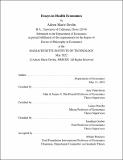Essays in Health Economics
Author(s)
Devlin, Aileen Marie
DownloadThesis PDF (2.386Mb)
Advisor
Finkelstein, Amy
Poterba, James
Gruber, Jonathan
Terms of use
Metadata
Show full item recordAbstract
This thesis consists of three chapters on various health economics topics.
The first chapter investigates how physicians respond to Medicare reimbursement rate changes. The Affordable Care Act increased reimbursements in four states differentially across physicians. I run a difference in difference (DID) comparing physicians with higher reimbursement increases to those with lower increases. I focus on office-based physicians and find that physicians with higher reimbursement increases were more likely to continue providing office-based care, while physicians with relatively lower increases were more likely to move all their provision to non-office facilities (e.g., hospitals), which suggests vertical integration. I also find that physicians who remain office-based exhibit a positive supply response. My findings suggest that Medicare reimbursement directly affects both access to care and vertical integration.
The second chapter, joint with Annetta Zhou, explores the impacts of urgent care clinics (UCCs). They can divert patients out of more expensive emergency departments but they also decrease hassle costs of care potentially increasing aggregate utilization. We use a stacked DID to investigate the impact of clinic openings in Massachusetts. We find that opening UCCs decrease emergency department visits among people living near the UCC---on average, every additional four UCC visits are offset by one fewer emergency department visit. We find evidence of small diversion out of retail clinics, but no evidence of diversion out of other outpatient providers. We investigate differential impacts based on the ownership of the clinics and find that hospital-affiliated UCCs divert more patients out of emergency departments.
The third chapter describes how exposure to telemedicine affects subsequent utilization in Medicare from 2006 to 2016. After a first telemedicine visit, patients were somewhat persistent with it, which I benchmark to persistence with in-person care with a unique provider. In a matched sample, telemedicine was roughly half as persistent as in-person care with a unique provider. However, telemedicine patients whose providers continued providing any telemedicine, a group likely to retain access, were quite persistent. If telemedicine were an experience good then exposure should lead to persistent utilization in the absence of constraints. My results thus suggest supply constraints were a limiting factor.
Date issued
2022-05Department
Massachusetts Institute of Technology. Department of EconomicsPublisher
Massachusetts Institute of Technology